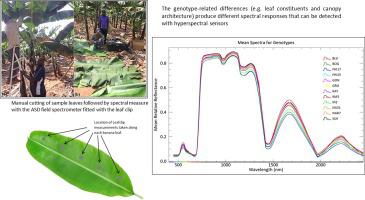ISPRS Journal of Photogrammetry and Remote Sensing ( IF 10.6 ) Pub Date : 2020-07-17 , DOI: 10.1016/j.isprsjprs.2020.06.023 Priyakant Sinha , Andrew Robson , Derek Schneider , Talip Kilic , Harriet Kasidi Mugera , John Ilukor , Jimmy Moses Tindamanyire

|
Bananas and plantains provide food and income for more than 50 million smallholder farmers in East and Central African (ECA) countries. However, banana productivity generally achieves less than optimal yield potential (<30%) in most regions, including Uganda. Numerous studies have been undertaken to identify the key challenges that smallholder banana growers face at different stages of the banana value chain, with one of the main constraints being a lack of policy-relevant agricultural data. The World Bank (WB) initiated a methodological survey design aimed at identifying the distribution of banana varieties across a number of key Ugandan growing regions, at the individual household scale. To achieve this outcome a number of approaches including ground-based surveys, DNA tissue collection of selected banana plants and remote sensing were evaluated. For the remote sensing component, the set objectives were to develop statistical models from the hyperspectral reflectance properties of individual leaves that could differentiate typical ECA banana varieties, as well as their parentage (usage). The study also explored the potential of extrapolating the ground-based hyperspectral measures to high-resolution WorldView-3 (WV3) satellite imagery, therefore creating the potential of mapping the distribution of banana varieties at a regional scale. The DNA testing of 43 banana varieties propagated at the National Banana Research Program site at National Agricultural Research Organization (NARO) research station in Kampala, Uganda, identified 12 genetically different varieties. A canonical powered partial least square (CPPLS) model developed from hyperspectral reflectance properties of the sampled banana leaves successfully differentiated BLU, BOG, GON, GRO and KAY genotypes. The Random Forest (RF) algorithm was also evaluated to determine if spectral bands coinciding with those provided by WV3 data could segregate banana varieties. The results suggested that this was achievable and as such presents an opportunity to extrapolate the hyperspectral classifications to broader areas of land. The ability to spectrally differentiate these five genotypes has merit as they are not typical east African varieties. As such, identifying the distribution and density of these varieties across Uganda provides vital information to the banana breeders of NARO of where their new varieties are being disseminated too, data that has been previously difficult to obtain. Although the results from this pilot study indicated that not all banana varieties could be spectrally differentiated, the methodology developed and the positive results that were achieved do present remote sensing as a complimentary technology to the ongoing surveying of banana and other crop types grown within Ugandan household farming systems.
中文翻译:

原位高光谱遥感用于区分乌干达种植的12种香蕉基因型的潜力
香蕉和大蕉为东非和中非(ECA)国家的5000万小农提供食物和收入。但是,在包括乌干达在内的大多数地区,香蕉的生产力通常达不到最佳的增产潜力(<30%)。已经进行了许多研究来确定小农香蕉种植者在香蕉价值链的不同阶段面临的主要挑战,其中主要的限制因素之一是缺乏与政策相关的农业数据。世界银行(WB)启动了一种方法学调查设计,旨在确定单个家庭规模的香蕉品种在乌干达多个主要生长地区的分布。为了实现这一结果,采取了多种方法,包括基于地面的调查,评价了选定香蕉植物的DNA组织收集和遥感。对于遥感组件,设定的目标是根据单个叶片的高光谱反射特性开发统计模型,这些模型可以区分典型的ECA香蕉品种及其亲本(用法)。这项研究还探索了将地面高光谱措施外推到高分辨率WorldView-3(WV3)卫星图像的潜力,从而创造了绘制区域性香蕉品种分布图的潜力。在乌干达坎帕拉国家农业研究组织(NARO)研究站的国家香蕉研究计划站点传播的43个香蕉品种的DNA测试中,鉴定出12种遗传上不同的品种。通过采样香蕉叶片的高光谱反射特性开发的规范幂次偏最小二乘(CPPLS)模型成功区分了BLU,BOG,GON,GRO和KAY基因型。还对随机森林(RF)算法进行了评估,以确定与WV3数据提供的光谱带重合的光谱带是否可以隔离香蕉品种。结果表明这是可以实现的,因此提供了将高光谱分类外推到更广阔土地面积的机会。光谱区分这五个基因型的能力是值得的,因为它们不是典型的东非品种。因此,确定这些品种在乌干达的分布和密度,可为NARO的香蕉育种者提供重要信息,这些育种者也将在此传播新品种,以前很难获得的数据。尽管这项初步研究的结果表明并不是所有香蕉品种都可以进行光谱区分,但是开发的方法和取得的积极成果确实将遥感作为对正在进行的乌干达家庭中种植的香蕉和其他作物类型的调查的补充技术农业系统。











































 京公网安备 11010802027423号
京公网安备 11010802027423号